#Avatamsaka Sutra
Text
From “The Flower Bank World” in the Avatamsaka Sutra

The Buddhist Painting of Songgwansa Temple, Suncheon, South Korea (Illustration of Avatamsaka Sutra)
“Then Universally Good also said to the assembly, ‘In the land masses of this ocean of worlds are seas of fragrant waters, as numerous as atoms in unspeakably many buddha-fields. All beautiful jewels adorn the floors of those seas; gems of exquisite fragrances adorn their shores. They are meshed with luminous diamonds. Their fragrant waters shine with the colors of all jewels. Flowers of all kinds of gems swirl on their surfaces. Sandalwood powder settles on the bottom of the seas. They emanate the sounds of Buddhas’ speech. They radiate jewellike light. Boundless enlightening beings, holding various canopies, manifest mystic powers causing the adornments of all worlds to appear therein. Stairways of ten kinds of precious substances are set out in rows, with balustrades of ten kinds of jewels surrounding them. White lotuses ornamented with jewels, as many as atoms in four continents, are spread over the waters, in full bloom. There are unspeakable hundreds of thousands of billions of trillions of banners of ten precious elements, banners of belled gauze of raiments of all jewels, as many as sand grains in the Ganges river, jewel flower palaces of boundless forms, as many as sand grains in the Ganges river, a hundred thousand billion trillion lotus castles of ten precious substances, forests of jewel trees as many as atoms in four continents, networks of flaming jewels, as many sandalwood perfumes as grains of sand in the Ganges, and jewels of blazing radiance emitting the sounds of Buddhas’ speech…”
--From book five “The Flower Bank World” in the The Flower Ornament Scripture (Buddhāvataṃsaka Sūtra), translated from Chinese by Thomas Cleary. The various sutras were originally composed in Sanskrit and compiled and translated into Chinese in the 5th century CE. Thomas Cleary’s English translation is based on the Chinese translation done by the Khotanese monk Shikshananda (652-710 CE), who translated it at the request of the Tang Empress.
I stumbled upon this sutra in the back of a book that included a ‘glossary of buddhist terms’ while at a Zen meditation retreat. Flower cosmology? That sounds like my shit. Since I didn’t have my phone I wrote the name down on a piece of paper and slipped it into my backpack. It really is as incredible as I imagined it to be.
“Alan Fox has described the sutra's worldview as ‘fractal’, ‘holographic’, and ‘psychedelic’”—yes.
“In the Huayan school, the teaching of interpenetration is depicted through various metaphors, such as Indra's net, a teaching which may have been influenced by the Gandhavyuha chapter's climax scene in Vairocana's Tower. Indra's net is an infinite cosmic net that contains a multifaceted jewel at each vertex, with each jewel being reflected in all of the other jewels, ad infinitum. Thus, each jewel contains the entire net of jewels reflected within.”
#Avataṃsaka Sūtra#Avatamsaka Sutra#flower garland sutra#Hwaeom#Kegon#Huayan Buddhism#Huayan#chan buddhism#Xianshou#water#buddhism#religion#mysticism#Thomas Cleary#literature#philosophy#metaphysics of flowers#The Flower Ornament Scripture#Buddhāvataṃsaka Sūtra#Buddhāvataṃsaka-nāma-mahāvaipulya-sūtra#Sanskrit
66 notes
·
View notes
Text
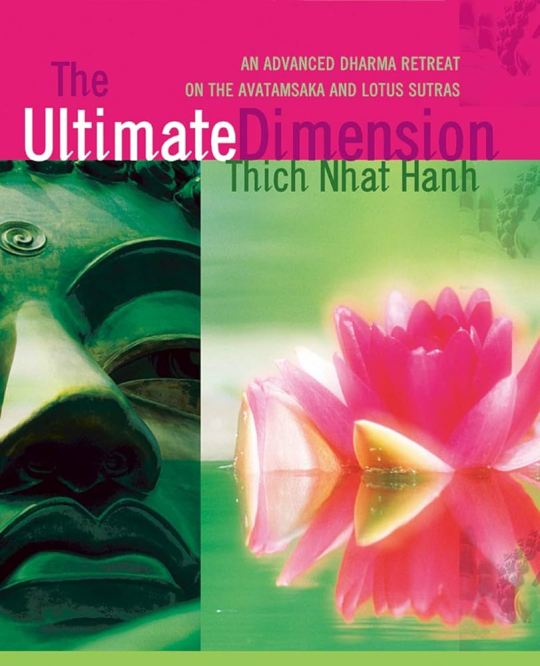
“Mindfulness practice is the kind of practice that allows us to enter the wonderful realm of the Avatamsaka. There is a lot of light, of space, of flowers, of joy, of peace, of loving-kindness in the realm of Avatamsaka. And the realm of Avatamsaka is available to us at any time. We need only to use the energy of mindfulness in order to step into that world where you can meet the Buddhas and Bodhisattvas and all the wonderful things.”
― Thich Nhat Hanh, The Ultimate Dimension : An Advanced Dharma Retreat on the Avatamsaka and Lotus Sutras
This is one of Thich Nhat Hanh's best teachings.
#Lotus Sutra#Avatamsaka Sutra#Thich Nhat Hanh#Buddha#Bodhisattva#Mindfulness practice#Path of the Bodhisattva
2 notes
·
View notes
Text
much as i hate to agree with someone as curmudgeonly as nichiren, i think maybe the lotus sutra is the highest of the buddhist sutras after all
#the devadatta chapter in particular#i used to really like the avatamsaka sutra#actually i still do#but as much as i think it's closer to capturing reality than the lotus#the lotus has a much stronger salvific power#in my opinion#and what is buddhadharma for if not for saving sentient beings
0 notes
Text
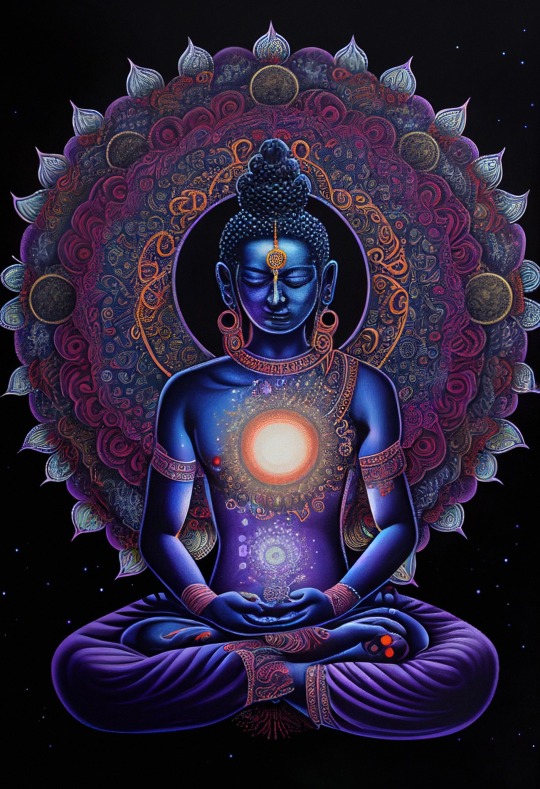
'Cosmic Buddha'
Talon Abraxas
The Avatamsaka Sutra
The Avatamsaka sutra also states that the wisdom of the Buddha (the Tathagata) is present everywhere in the universe, indeed, it is present within every living being. Thus, the sutra states (in chapter 32, Manifestation of the Tathagata): Son of Buddha, the wisdom of Tathagata is present everywhere.
32 notes
·
View notes
Note
So, what IS the Samadhi Fire/True Fire of Samadhi? It can't be an average flame if it can take out Sun Wukong himself in JttW and the name sounds like it means something, but I can't find any context when I look it up.
Journey to the West states that Samādhi fire is not like earthly or heavenly flame. It is something more. Part of a poem in chapter 41 reads:
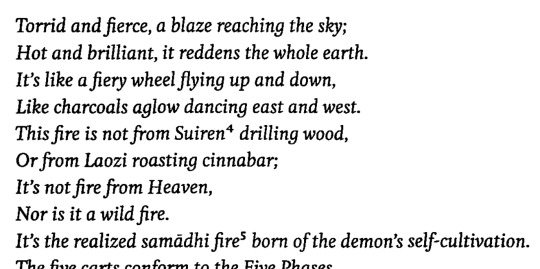
(Wu & Yu, 2012, vol. 2, p. 225)
The general concept of Samādhi (Sk: "concentration"; Ch: sanmei, 三昧) refers to an advanced level of meditation where one can "establish and maintain one-pointedness of mind on a specific object of concentration" (Buswell & Lopez, 2014, p. 743). Some Hindu and Buddhist sources associate it with a spiritually cleansing flame. One example comes from the Gaṇḍavyūha section of the Avataṃsaka Sūtra (Ch: Dafang guangfo huayan jing, 大方廣佛華嚴經; compiled by the 3rd or 4th-century CE).
Sudhana (Ch: Shancai tongzi, 善財童子; i.e. Red Boy), the holy work's protagonist, seeks out 53 teachers in the course of his spiritual cultivation. His ninth instructor, a learned Brahmin named Jayoṣmāyatana (Ch: Shengre poluomen, 勝熱婆羅門; lit: "Victorious Heat Brahmin") is said to have achieved "the light of the concentration [i.e. Samādhi] of adamantine flame" (jingang yan sanmei guangming, 金剛焰三昧光明) (Clearly, 1993, p. 1218). The fire that he produces is so powerful that it scares even the gods and demons. Though, the point of the flames appears to be incineration of the ego and desires and illumination of the mind. Sudhana follows his instructions by throwing himself into the fire, thus gaining a higher level of spiritual knowledge.
Here is a translation of that section of the sutra (warning: it is wordy):
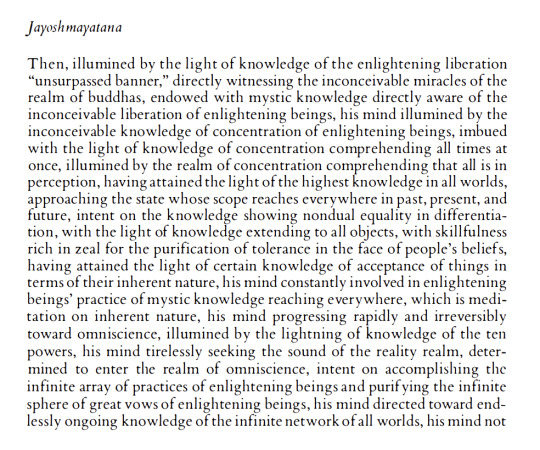

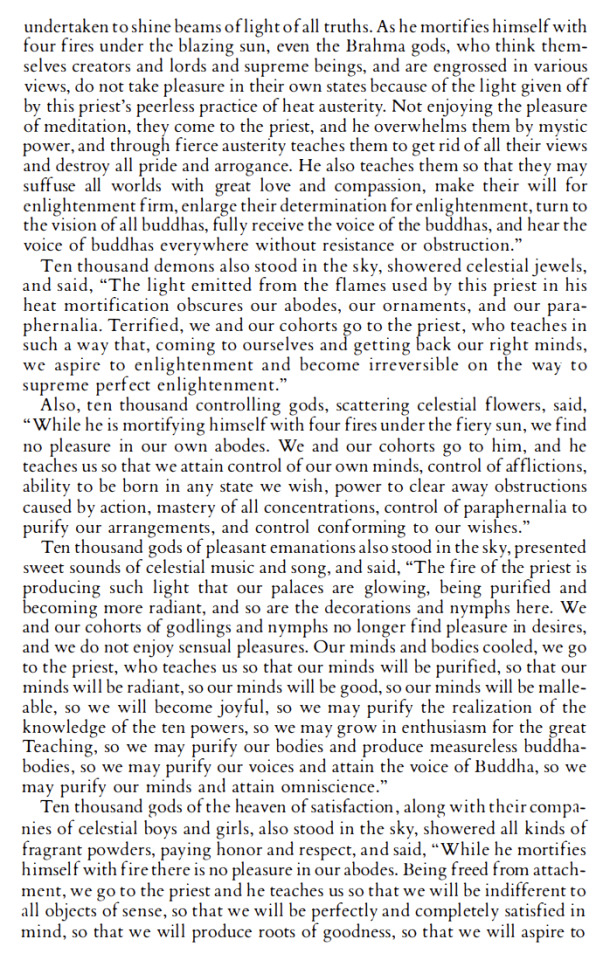
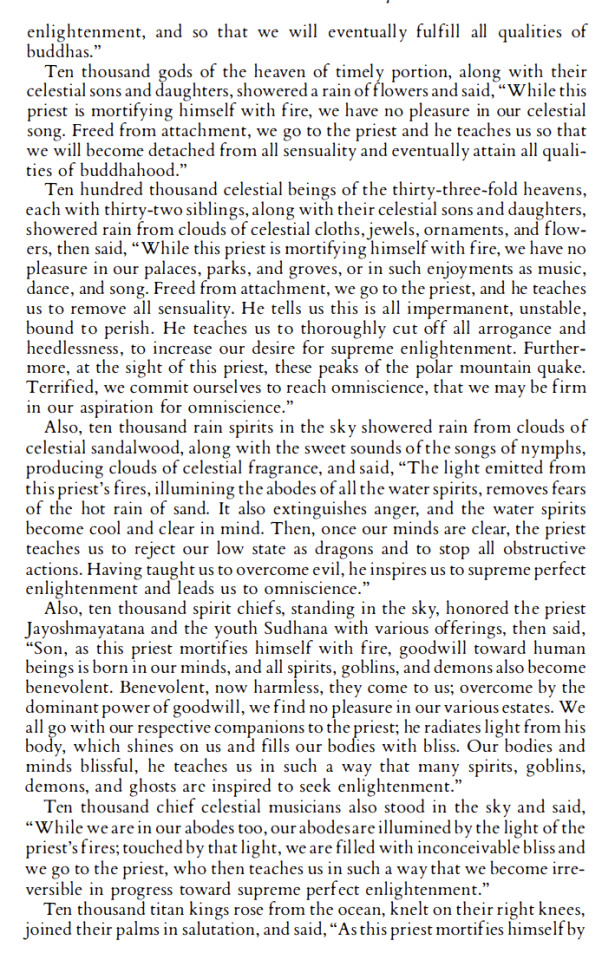
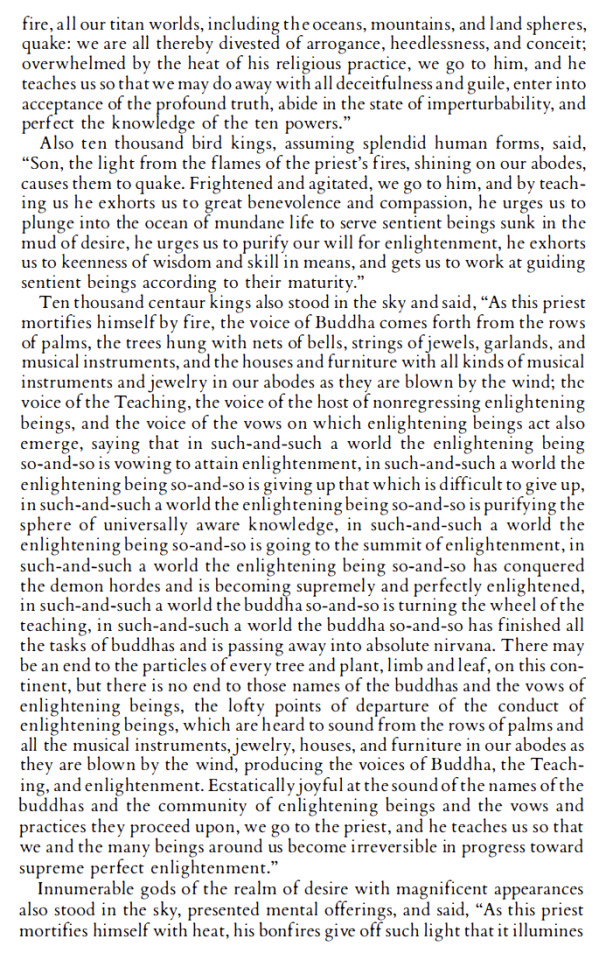
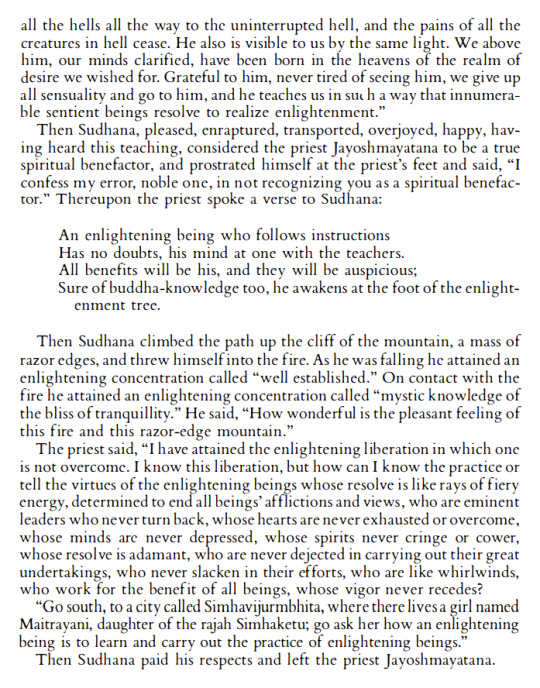
(Clearly, 1993, pp. 1217-1222)
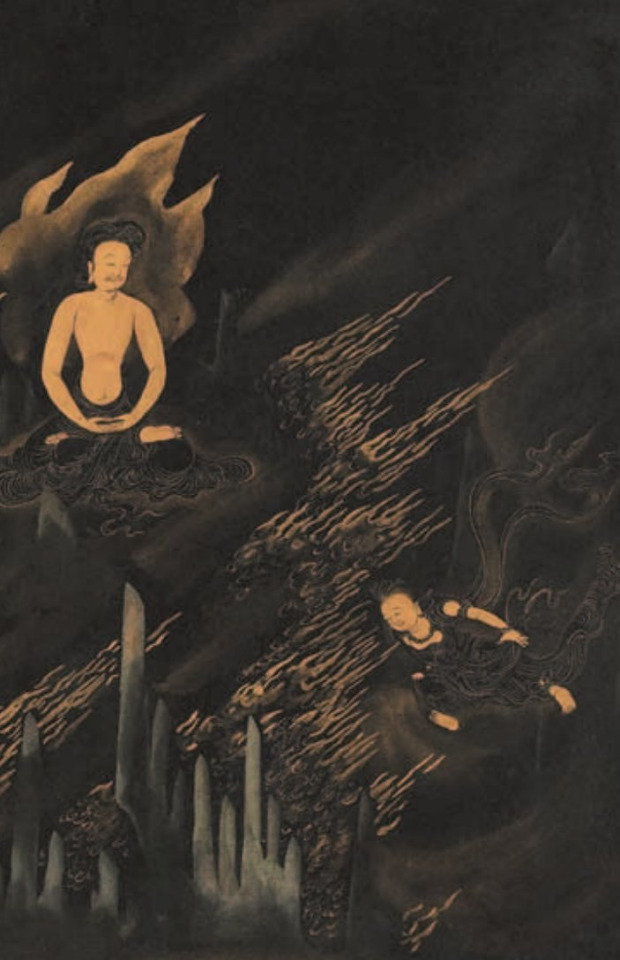
A Song or Ming-era Japanese painting of the fire brahmin and Sudhana.
Sources:
Buswell, R. E. , & Lopez, D. S. (2014). The Princeton Dictionary of Buddhism. Princeton University Press.
Cleary, T. (1993). The Flower Ornament Scripture: A Translation of the Avatamsaka Sutra. Boston: Shambhala.
Wu, C., & Yu, A. C. (2012). The Journey to the West (Vols. 1-4) (Rev. ed.). Chicago, Illinois: University of Chicago Press.
#Samadhi fire#Samadhi flame#Red Boy#Red Son#Journey to the West#JTTW#Buddhism#Hinduism#Samadhi#Lego Monkie Kid#Sudhana#Shancai tongzi#Chinese religion#Indian religion#meditation
98 notes
·
View notes
Text



**persona 3 spoilers**
ryoji on the nature of life
after having drawn my previous comic, the way rivers flow to the sea, and how the sea evaporates into rain to restart the cycle made me think of something.
The Avatamsaka Sutra seems to explore the idea that all beings are equal - that universe itself is no different from a single entity, and that it is the mind brings together the universe and the universe is you. That goes with what's happened in the final battle of P3 and how the protagonist brought forth the universe arcana. I'm no expert on it, so I'm not sure if this explanation of it is entirely accurate, but it seemed it could align with how things go in P3 and the persona universe
and I wanted to see ryoji say life's very precious and support it. That's what he'd say for sure!
#persona 3#persona 3 reload#p3 reload#zen and rei#ryomina#sort of because ryoji loves life and he is life#persona#persona 3 reload spoilers#spoilers#doodle#this game makes me think a lot...#which is a great thing#persona q
26 notes
·
View notes
Text
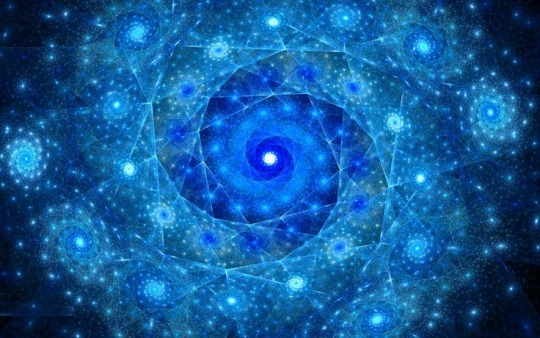
Far away in the heavenly abode of the great god Indra, there is a wonderful net which has been hung by some cunning artificer in such a manner that it stretches out infinitely in all directions. In accordance with the extravagant tastes of deities, the artificer has hung a single glittering jewel in each "eye" of the net, and since the net itself is infinite in dimension, the jewels are infinite in number.
There hang the jewels, glittering "like" stars in the first magnitude, a wonderful sight to behold. If we now arbitrarily select one of these jewels for inspection and look closely at it, we will discover that in its polished surface there are reflected all the other jewels in the net, infinite in number. Not only that, but each of the jewels reflected in this one jewel is also reflecting all the other jewels, so that there is an infinite reflecting process occurring.
The Buddha in the Avatamsaka Sutra's 30th book states a similar idea:
If untold Buddha-lands are reduced to atoms,
In one atom are untold lands,
And as in one,
So in each.
The atoms to which these Buddha-lands are reduced in an instant are unspeakable,
And so are the atoms of continuous reduction moment to moment
Going on for untold eons;
These atoms contain lands unspeakably many,
And the atoms in these lands are even harder to tell of.
Book 30 of the sutra is named "The Incalculable" because it focuses on the idea of the infinitude of the universe and as the cosmos is unutterably infinite, and hence so is the total scope and detail of knowledge and activity of enlightenment.
In another part of the sutra, the Buddhas' knowledge of all phenomena is referred to by this metaphor: The Buddhas know all phenomena come from interdependent origination.
They know all world systems exhaustively. They know all the different phenomena in all worlds, interrelated in Indra's net.
***
12 notes
·
View notes
Text
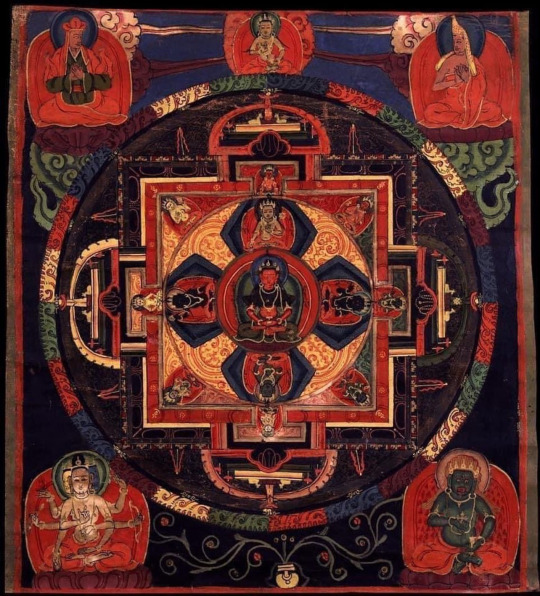
I see as many Buddhas as atoms in a hundred million lands
In one moment of consciousness, Showing the world in many ways Tranquility in an instant.
Avatamsaka Sutra - Flower Ornament Scripture
The Mandala is of Amitabha/Amitayus Buddha Sarvadurgati Tantra
6 notes
·
View notes
Text
Lingshan Recluse: "Nader and Simin: A Separation" - Those honest, terrible ordinary Iranians
You should watch this film before reading this article. Otherwise you may not know what I'm talking about. I promise this is not a movie that will make you fall asleep.
This is the best Iranian film I've ever seen. To be precise, this is the second Iranian film I've seen. The first one was "Persepolis," which was all black and white animated characters. If "Escape from Tehran" also counts as an Iranian film, then this would be the third. This film allowed us to understand the lives of Islamic adherents living in Iran. Previously, your understanding of Islam was limited to the endless violent incidents. For Iran, we are all too familiar with Ahmadinejad, their covert nuclear program, Iranian women in black veils, and topics like when will the US and Iran go to war. You had never understood ordinary Iranians before. From this film we can see how they live, how they balance cause and effect.
To be honest, the prudence towards cause and effect of the female housekeeper who does nursing work in the film puts me to shame - although she may not understand too much about cause and effect. Growing up in a country full of lies, even as Buddhists, sometimes we still habitually tell some lies. You will feel very uncomfortable seeing those honest, terrible, rigid ordinary Iranians in the film. Their piety and seriousness towards religion far exceeds ours. When she was unsure if changing the pants for an elderly paralyzed man of the opposite sex would violate Islamic doctrine, she even called to consult religious experts if doing so would be a sin. Of course, Buddhists would say such a religion is too rigid. We would say: they lack wisdom. But their seriousness towards faith is really something we Buddhists can learn from.
In their world, the Quran is like a prophet. If you speak in front of the Quran, it's equal to speaking in front of the prophet, and people around have no reason not to believe you. They don't believe anyone would dare to lie before Allah. I don't think many Chinese Buddhists would refrain from lying just because there's a copy of the Avatamsaka Sutra nearby. Even with their hand on the Diamond Sutra, many Chinese Buddhists can still lie without blushing. In China, lying has almost become a necessary survival skill.
I don't know how many Chinese people can understand such a film. In a country without faith, you would find them too rigid. You might even mock them. When I was very little, people around me already found it unbelievable that in the TV dramas made by Hong Kongers, people would not lie in court after swearing on the Bible. In a country lacking in faith, people generally do not understand the need to be responsible for their body, speech and mind.
At the end of the film, Nader and Simin decided to settle with the other party through monetary compensation, but they wanted the other party to swear before the Quran: her miscarriage was caused by being pushed by the employer. But the other party chose to give up the compensation. Because they feared the consequences of lying before the Quran. Although in some ways, her miscarriage was indeed related to the employer - she was hit by a car while protecting Nader's father - but it wasn't because of his push, so she couldn't say that. She couldn't lie before Allah. She feared the consequences.
I recommend all Buddhists watch this film. I think you can see from it how far you still are from deeply believing in cause and effect. And deeply believing in cause and effect - this is just the minimum standard for Buddhists. I know most Buddhists are only close to being Buddhists - even being close to Buddhists is still very distant. In fact, if I say someone is close to being a Buddhist, that is almost praise to me. If after studying Buddhism for ten years, you become close to being a Buddhist, you can almost be proud of it. I feel most Chinese Buddhists (especially some who claim to practice Vajrayana) their goal should not be attaining Buddhahood in this lifetime, they should set becoming a Buddhist in this lifetime as their highest goal. Becoming a Buddhist means you accept the four seals. Although this sounds not difficult, in actuality, it is a very high level requirement. Very few Buddhists truly accept the four seals. Most Buddhists neither understand nor accept the four seals, so when something happens they say: How could this happen? Why did this happen? This is not understanding the four seals.
If you watch this film, if you see those honest, terrible ordinary Iranians - how they speak plainly without exaggerating, occasionally telling a lie would cause them severe psychological barriers - and don't feel the slightest shame afterwards, then you must be amazing - either you're already doing as well as the people in the film or better, or you completely lack a sense of shame. Only these two kinds of people would not feel ashamed.
In China, many people can tell lies without any psychological barriers at all, many people can casually make promises they never intended to fulfill. Such people, from children to adults, are everywhere in China. The result is you don't dare trust anyone except parents and family. When someone tells you something, our first reaction is: Really? You're not lying to me right? Chinese Buddhists, growing up in such an environment, are also inevitably influenced. Thus, I especially recommend Chinese Buddhists watch such films.
You can watch this film through downloading, but if you like it, please go to the theater again and pay to watch it once more. Or purchase the official DVD. The reason is simple. If we all just watch films this way, then theaters will have no business, theaters with no business means creators have no money to eat. Creators with no money to eat will have to switch professions, like go wash dishes. They will no longer create. Then we won't be able to see their better works. This is cause and effect. Therefore, please respect other people's intellectual labor.
Lingshan Recluse wrote this on December 14, 2012.
Copyright Notice:All copyrights of Ling Shan Hermit's articles in Simplified and Traditional Chinese, English, and other languages belong to the natural person who owns "Ling Shan Hermit". Please respect copyright. Publishers, media, or individuals (including but not limited to internet media, websites, personal spaces, Weibo, WeChat public accounts, print media) must obtain authorization from Ling Shan Hermit before use. No modifications to the articles are allowed (including: author's name, title, main text content, and punctuation marks). We reserve all legal rights.
灵山居士:《纳德与西敏》——那些诚实的可怕的伊朗普通人
5 notes
·
View notes
Text
Speedrunning my journey to bodhisattvahood by playing Cook Serve Delicious 2 while listening to a lecture on the Avatamsaka Sutra and gyrating my body and mind to deflect the Hitler Particle Quantum Ray
0 notes
Text
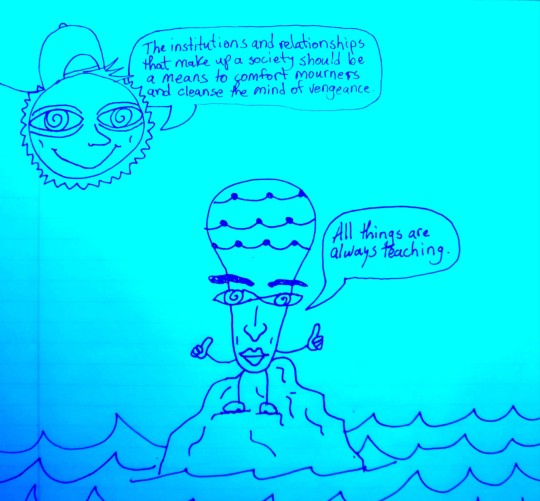
quotes from Kayanasenh Paul Williams (modified slightly) in his version of the Great Law of Peace and Tom Cleary discussing the Avatamsaka Sutra.
#haudenosaunee#buddhism#socialism#anarchism#art#doodles#mahayana#communism#marxism#books and reading#books recommendations#books
0 notes
Text
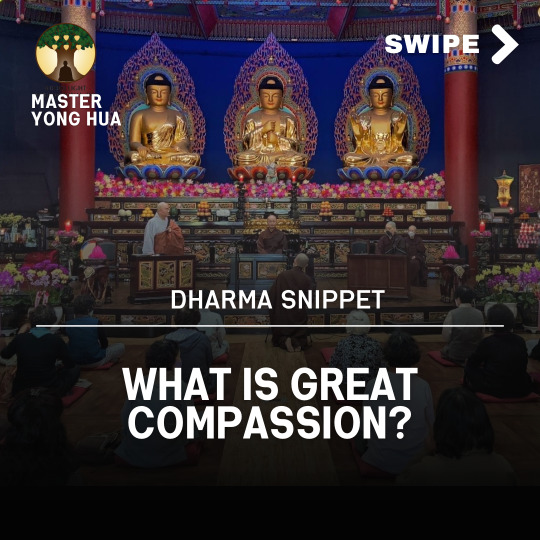



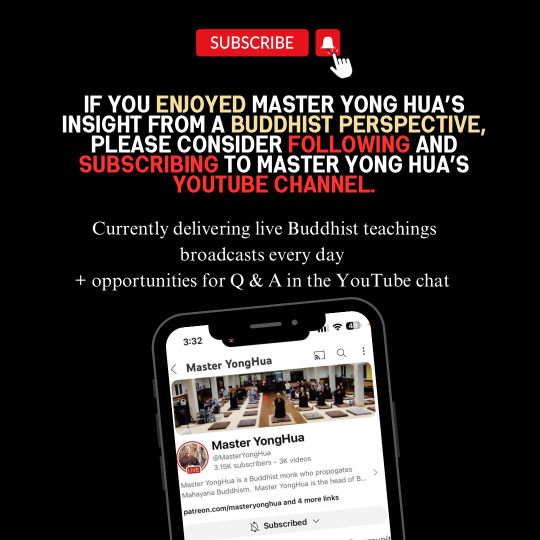
What is great compassion? Buddhist teaching by Master Yong Hua.
If interested, please search '08) Chan Qi • The Avatamsaka Sutra - Chapter 01 (84) - 20231203' on Master Yong Hua's YouTube channel.
#buddhism#buddha#buddhist#shakyamuni buddha#guanyin#amitabha#meditation#meditate#vipassana#spiritual awareness#spiritual awakening#yoga#inner peace#mindfulness#zenmeditation#life quote#quotes
1 note
·
View note
Quote
Any account of Cleary’s translations must commence with his monumental rendition of the Avatamsaka (Flower Ornament) Sutra, more than 1600 pages, one of the most stimulating of Mahayana texts. It is replete with luminous visions of bodhisattva activity and exalted experiences of mind and reality, conveyed with lush, psychedelic, evocative imagery. As the inspiration for the Chinese Huayan teachings (Kegon in Japanese) it is highly influential for all East Asian Buddhism. In his Huayan class I attended, Cleary mentioned that he recited aloud the entire Avatamsaka Sutra in Chinese seven times before he started translating it. Cleary’s Entry into the Inconceivable is one of the most valuable books on the dialectical Huayan philosophy, providing translations of the dense, profound writings from the Chinese Huayan founders. As with most of his translations, Cleary’s introductory commentaries are extremely informative.
In Appreciation of Thomas Cleary: A Personal Remembrance | Sangha News Journal
0 notes
Text

They accomplished the Thus Come One’s Ten Powers, his fearlessnesses, his courage, and his self-mastery, and with a lion’s roar, they profoundly entered the great ocean of limitless eloquence.
—Avatamsaka Sutra, Chapter 39, Entering the Dharma Realm, Section 1.
Bodhisattva Mystic Eye
Talon Abraxas
The Buddha’s Ten Wisdom Powers from the Avatamsaka Sutra:
1.The wisdom power that knows what is the case and what is not the case. In the context of fulfilling his vows to wake others up, with this power the bodhisattva cuts through to the heart of each different situation, so that no matter what happens to any particular sentient being, the bodhisattva immediately knows factually what is up, without delusion, personal prejudice, or alternative facts. With this power the bodhisattva knows immediately whether or not this person can be saved now or perhaps later, and by whom.
2.The wisdom power that knows karmic retribution in the three periods of time. The things that happen in our lives, both happy and miserable, result from prior causes. The bodhisattva, face to face with each individual’s sliding scale of karmic rewards, knows clearly, without mistake, the karmic web that caused the situation and the results of those causes, present and future. With this knowledge, they can respond skillfully to the individual’s needs and can know to what degree they can get involved in a person’s ledger of karmic deeds and misdeeds.
3.The wisdom power that knows the dhyanas, the samadhis, and the liberations. This power suggests how states of meditation latent in the human mind contribute to a bodhisattva’s ability to teach.
4.The wisdom power that knows the quality of an individual’s sense faculties. The bodhisattva is better able to teach living beings when they know clearly how an individual perceives principles; further, they understand the five faculties inherent in each living being: faith, energy, mindfulness, concentration, and wisdom. How keen are their faculties? How will they respond to certain teachings, be they devotional, physical, intellectual, or emotional?
5.The wisdom power that knows the variety of sentient beings’ understandings. A bodhisattva will teach more effectively if they know clearly what their student understands. It helps to know their likes and dislikes, their language and logical skills, etc.
6.The wisdom power that knows the variety of living beings’ realms. Knowing how somebody has incarnated over their lifetimes, the dharma realms they have passed through, a bodhisattva has a better chance of teaching them. Devas who have fallen back to the human realm have an attitude toward blessings that is different from that of a being from the animal realm that has only recently gained a human body.
7.The wisdom power that knows where all paths lead. The bodhisattva knows exactly where a sentient being’s every action, word, and thought in cultivation will take them. This knowledge is beneficial when mentoring someone. Which dharma-gateway will take them most efficiently from their current state to where they need to go next? This power is forward-looking.
8.The wisdom power that knows the unobstructed function of the deva’s/celestial eye. This wisdom power is shared with the Six Psychic Powers and the Five Spiritual Eyes; it allows the Bodhisattva to see in real time what happens in the heavens and the hells and what the current dynamic conditions are in the present, on the fly.
9.The wisdom power that knows past lives without errors. This power faces backwards, allowing the bodhisattva to pinpoint where living beings have been amid the six destinies and where their tendencies lie. It reveals the situations before this life and where a being might fit in the future.
10.The wisdom power that knows how to end bad habits forever. Energy that gets grooved in by repetitive habits is as resistant to change as water running along a riverbed. The bodhisattva, with this wisdom power, knows how to effect genuine personal transformations toward wholesome habits, and how to keep this particular sentient being securely on the path to nirvana.
16 notes
·
View notes
Text
Morning meditation: The Buddha is always present.
Morning meditation: The Buddha is always present.
https://wp.me/pFy3u-7L5
‘The Buddha is always present so it is always the right dharma age. This is the teaching of ultimate meaning.’“Exposition of the Avatamsaka Sutra”.
Chinul Sunim[Encouragement to practice]
Three jewelwing’s enjoying the sunshine.
On our Twitter account, Buddhism Now @Buddhism_Now, most mornings we post a ‘morning meditation’ like the one above.
On the net, of course, it’s morning, afternoon,…

View On WordPress
0 notes
Text
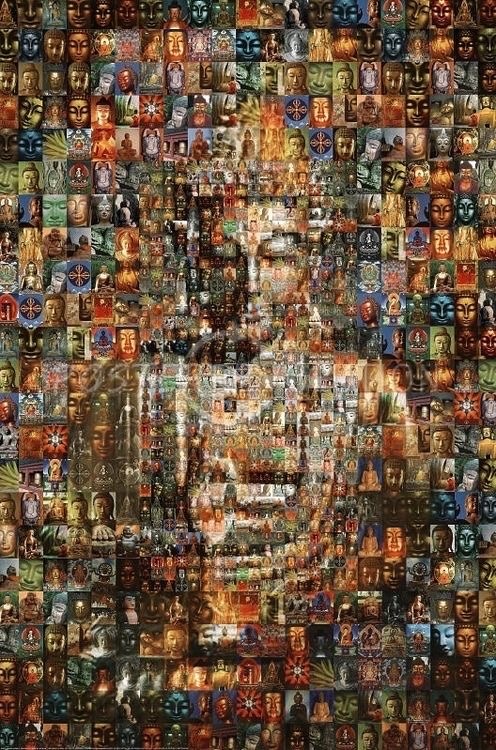
BUDDHA SPEAKS
Are you kind
To the helpless and lost?
Are you really compassionate
Toward evildoers?
Are you most happy
To see the success of others?
Are you indifferent, by the power of wisdom,
To those who annoy you for no reason?
Seeing people in the slumber of ignorance,
Do you firmly seek supreme enlightenment?
Would you not weary of endless ages
Of spiritual practice?
***AVATAMSAKA SUTRA
65 notes
·
View notes